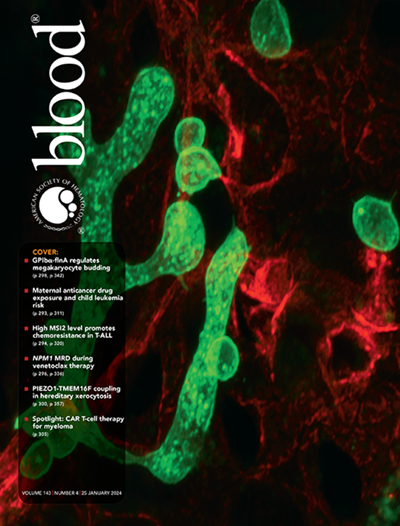BLAST:一种全球适用的、分子通用的慢性髓细胞白血病生存模型。
IF 21
1区 医学
Q1 HEMATOLOGY
引用次数: 0
摘要
我们试图建立慢性髓单细胞白血病(CMML)的生存模型,该模型主要基于临床变量,并检查突变和核型的额外影响。纳入了457例分子注释患者。多变量分析确定循环母细胞≥2%(1分),白细胞≥13 × 109/L(1分),重度(2分)或中度(1分)贫血是开发总体生存(OS)临床风险分层工具的首选风险变量,缩写为“BLAST”:低风险(0分;中位63个月);中度风险(1分;中位28个月;HR 2.2, 95% CI 1.6-3.0)和高风险(2-4分;中位13个月;5.4, 4.1 - -7.3);相应的3/5年OS率分别为68%/53%、43%/18%和12%/1%。BLAST模型的表现(3/5年时的AUC为0.77/0.85)与分子cmml特异性预后评分系统(CMML-mol;AUC 0.73/0.75)和国际预后评分系统-分子(IPSS-M;AUC 0.73/0.74)。多变量突变和核型分析鉴定PHF6MUT和TET2MUT为“有利”核型,DNMT3AMUT、U2AF1MUT、BCORMUT、SETBP1MUT、ASXL1MUT、NRASMUT、PTPN11MUT、RUNX1MUT、TP53MUT为“不利”核型。随后将分子信息编码到临床-分子风险联合模型(BLAST-mol;AUC为0.80/0.86(3/5年),包括上述BLAST临床风险变量和3层分子风险评分。BLAST和BLAST-mol随后通过两个单独的外部队列进行验证。母细胞转化的独立危险因素包括DNMT3AMUT、ASXL1MUT、PHF6WT、白细胞≥13 × 109/L、循环骨髓母细胞≥2%或≥10%。目前的研究提出了一个易于实现的、全球适用的、分子自适应的CMML风险模型。本文章由计算机程序翻译,如有差异,请以英文原文为准。
BLAST: A Globally Applicable and Molecularly Versatile Survival Model for Chronic Myelomonocytic Leukemia.
We sought to develop a survival model in chronic myelomonocytic leukemia (CMML) that is primarily based on clinical variables and examine additional impact from mutations and karyotype. 457 molecularly-annotated patients were considered. Multivariable analysis identified circulating Blasts ≥2% (1 point), Leukocytes ≥13 x 109/L (1 point), and severe (2 points) or moderate (1 point) Anemia as preferred risk variables in developing a clinical risk Stratification Tool for overall survival (OS), acronymized to "BLAST": low-risk (0 points; median 63 months); intermediate-risk (1 point; median 28 months; HR 2.2, 95% CI 1.6-3.0), and high-risk (2-4 points; median 13 months; 5.4, 4.1-7.3); the corresponding 3/5 year OS rates were 68%/53%, 43%/18%, and 12%/1%. BLAST model performance (AUC 0.77/0.85 at 3/5-years) was shown to be comparable to that of the molecular CMML-specific prognostic scoring system (CMML-mol; AUC 0.73/0.75) and the international prognostic scoring system-molecular (IPSS-M; AUC 0.73/0.74). Multivariable analysis of mutations and karyotype identified PHF6MUT and TET2MUT as being "favorable" and DNMT3AMUT, U2AF1MUT, BCORMUT, SETBP1MUT, ASXL1MUT, NRASMUT, PTPN11MUT, RUNX1MUT, TP53MUT, and adverse karyotype, "unfavorable". Molecular information was subsequently encoded in a combined clinical-molecular risk model (BLAST-mol; AUC 0.80/0.86 at 3/5-years) that included the aforementioned BLAST clinical risk variables and a 3-tiered molecular risk score. BLAST and BLAST-mol were subsequently validated by two separate external cohorts. Independent risk factors for blast transformation included DNMT3AMUT, ASXL1MUT, PHF6WT, leukocytes ≥13 x 109/L, and ≥2% circulating or ≥10% bone marrow blasts. The current study proposes an easy to implement, globally applicable, and molecularly adaptive risk model for CMML.
求助全文
通过发布文献求助,成功后即可免费获取论文全文。
去求助
来源期刊

Blood
医学-血液学
CiteScore
23.60
自引率
3.90%
发文量
955
审稿时长
1 months
期刊介绍:
Blood, the official journal of the American Society of Hematology, published online and in print, provides an international forum for the publication of original articles describing basic laboratory, translational, and clinical investigations in hematology. Primary research articles will be published under the following scientific categories: Clinical Trials and Observations; Gene Therapy; Hematopoiesis and Stem Cells; Immunobiology and Immunotherapy scope; Myeloid Neoplasia; Lymphoid Neoplasia; Phagocytes, Granulocytes and Myelopoiesis; Platelets and Thrombopoiesis; Red Cells, Iron and Erythropoiesis; Thrombosis and Hemostasis; Transfusion Medicine; Transplantation; and Vascular Biology. Papers can be listed under more than one category as appropriate.
 求助内容:
求助内容: 应助结果提醒方式:
应助结果提醒方式:


